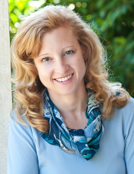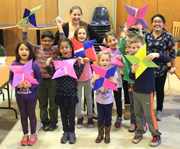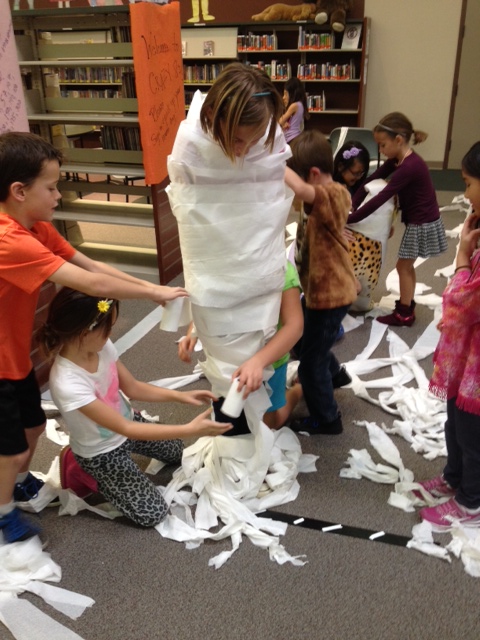The Harvard Family Research Project separated from the Harvard Graduate School of Education to become the Global Family Research Project as of January 1, 2017. It is no longer affiliated with Harvard University.
|
May 24, 2016 Q & A with Laura Overdeck of Bedtime Math: Helping Families and Children Cuddle Up to MathMargaret Caspe
|
FINE Newsletter, Volume VIII, Issue 2
Formula for Success: Engaging Families in Early Math Learning
Voices From the Field
 Bedtime Math is a nonprofit organization that strives to help kids love and appreciate math in their everyday lives. Bedtime Math provides families and children fun math stories and problems they can share together, and offers afterschool instructors and librarians a curriculum for running math clubs. HFRP recently caught up with Laura Overdeck, the founder of Bedtime Math, to learn more about her work.
Bedtime Math is a nonprofit organization that strives to help kids love and appreciate math in their everyday lives. Bedtime Math provides families and children fun math stories and problems they can share together, and offers afterschool instructors and librarians a curriculum for running math clubs. HFRP recently caught up with Laura Overdeck, the founder of Bedtime Math, to learn more about her work.
| Tell us a little bit about the inspiration behind Bedtime Math. | |
| People who are good at math, and who love math, think and talk about it and tinker with it everywhere, all the time—not just in school. Unfortunately, we live in a society that associates math with school. This is problematic, because math education in schools right now is limited. Schools often rely too heavily on work sheets instead of hands-on learning experiences. And learning in schools is not very personalized, so children who struggle with math early on often don’t have opportunities to catch up. Math is also not very well integrated with other subjects. Because of this, students are learning math in isolation from other subjects and struggling to see its relevance to their lives. Until schools can do a better job with creating hands-on, personalized, and integrated math education, those of us outside of school have a role in making sure it happens. So, in a rather unpremeditated way, my husband John and I began to tell math stories to our young children at night after we read them a book, and little by little, this grew into Bedtime Math. | |
| |
How does Bedtime Math work? |
|
People often tell me, “I know to read to my kids, but it never occurred to me to do math with them.” Bedtime Math fills this void, and gives families a way to get involved in their kids’ math learning in a fun way. It’s important to emphasize that these problems are not quizzes or workbooks. Although we provide families with the answers, they are intended to be fun ideas to get families and children taking a journey to talking about logic and finding solutions. For example, we created a nationwide math activity for preschools and families to get involved in called March of the Stuffed Animals. We are asking children to bring their favorite stuffed animals to school and take a census of them. We want math to be something exciting to all students—everywhere, all the time—and for schools to be a partner to help get this idea out there. |
|
|
|
In addition to your Bedtime Math program that is focused on math in the home, you also have the Crazy 8s Club. Tell us about that. |
|
|
|
|
|
We know that data are important to your work. Can you talk about the types of data that you collect and what you are finding? |
|
|
We’re really excited here because researchers at the University of Chicago recently conducted a randomized control trial of our app and found that using the app increases math achievement among first graders across the school year. What was really exciting was that even using the app as little as once a week makes a difference. We also found that the app makes a difference especially for children whose parents have anxiety about math. We speculate that what Bedtime Math is doing is giving families and children comfort in talking about numbers and awareness of how math is in everything, and that, in turn, is changing the types of conversations that are happening in the home. Because remember: Our app is not about instruction about math per se. It just offers short math problems. In addition to the external impact studies, we also collect data using a variety of metrics to help us improve what we do. We’re always interested in the types of content that families and children are most likely to read—anything about vehicles, animals, and food is always a big hit—and we find that videos are a big draw. For Crazy 8s, we look at retention of kids across sessions and to understand from coaches what some of the challenges are to holding math clubs. Some of the most common challenges are finding space and working out scheduling. |
| |
What recommendations would you offer families who want to get more engaged in their children’s math learning? |
| |
 It’s so important that families have a mind-set that math is casual. It’s something that happens as part of our everyday lives. For example, baking, carpentry, playing sports—they all involve mathematical reasoning, and it’s important for parents to feel comfortable and empowered to talk about math as they use it every day. It’s so important that families have a mind-set that math is casual. It’s something that happens as part of our everyday lives. For example, baking, carpentry, playing sports—they all involve mathematical reasoning, and it’s important for parents to feel comfortable and empowered to talk about math as they use it every day.
I also think it is important for families to wait for children to struggle with math problems. We often tell the coaches in the Crazy 8s program that it is good to let kids wrangle with a question and try to derive their own solution. They need time to figure out why answers are what they are because that is what math is. If possible, parents can also take a step back and help connect what’s happening in real life to things kids might come home with in school. For example, if you’ve just doubled the recipe you are baking with, you can specifically point out how this might relate to multiplying fractions on a work sheet. Finally, and maybe most importantly: Don’t say you hate math! You need to be aware of how you talk about math. |
|
This resource is part of the May 2016 FINE Newsletter. The FINE Newsletter shares the newest and best family engagement research and resources from Harvard Family Research Project and other field leaders. To access the archives of past issues, please visit www.hfrp.org/FINENewsletter.
|
|

 We want kids to enjoy math and see it everywhere, even older kids who might have outgrown having a parent read to them at night. So
We want kids to enjoy math and see it everywhere, even older kids who might have outgrown having a parent read to them at night. So